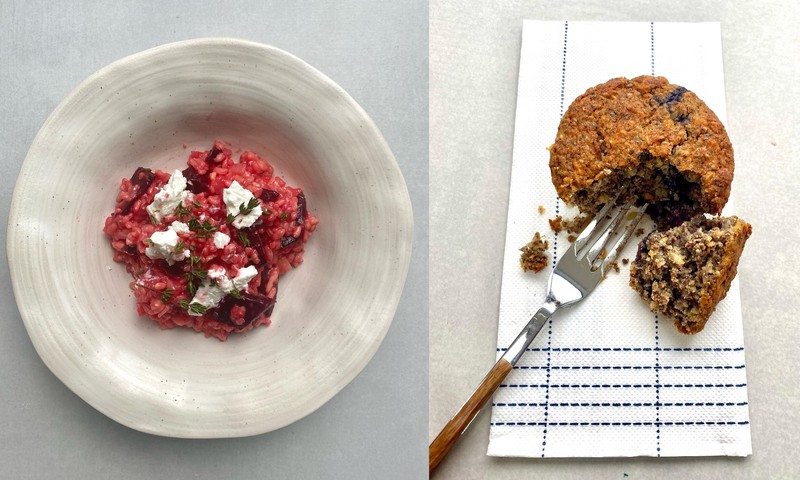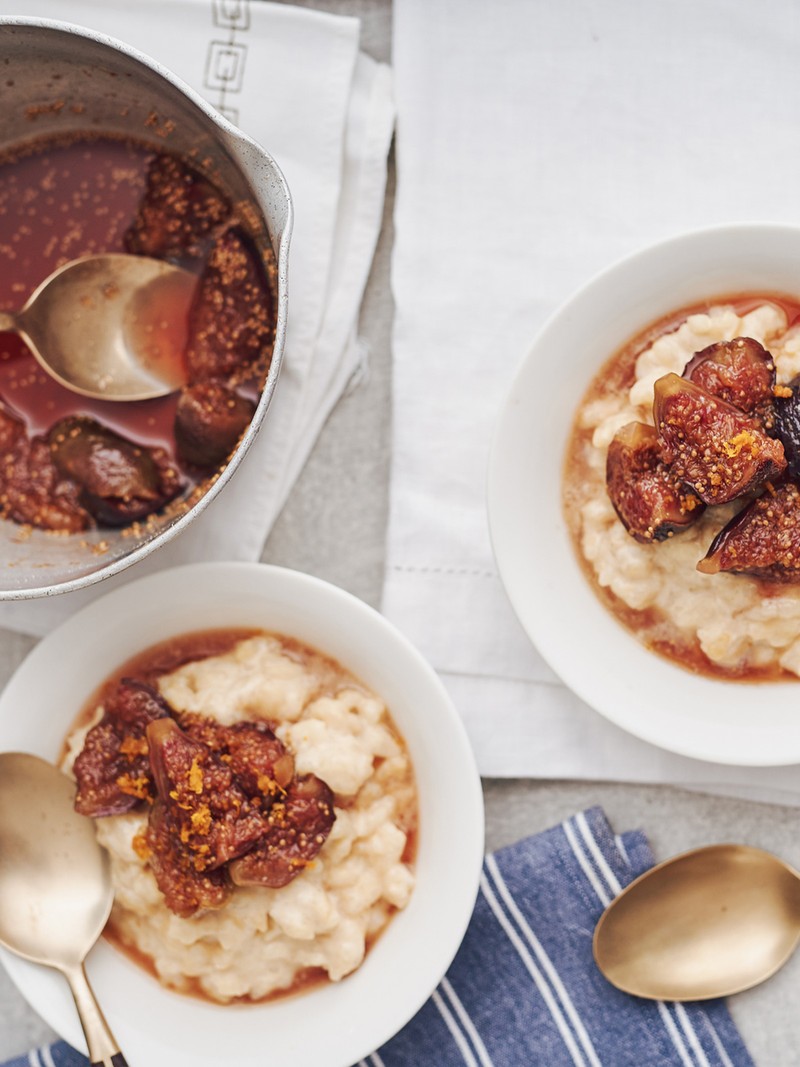What An Ayurvedic Expert Eats On Repeat
The change in seasons is a good time to rethink your rituals. In Ayurveda, the seasons of the year correspond to the three doshas: vata, pitta and kapha. As we move into autumn, we move from hot, sharp pitta season into cold, dry, rough and windy vata season. We can see this in the environment around us as the air turns cooler, the wind picks up and the leaves are dry and crunchy under our feet. Internally, we may still be carrying a lot of heat from the summer which, if we’re not eating the right foods, can be exacerbated by the arrival of drier weather, leading to symptoms like dry skin and hair loss. According to Ayurveda, this is the time to use plenty of healthy oils and warming spices at mealtimes, while reducing cold, dry foods like oat cakes, rice cakes and raw vegetables.
I start the day with a turmeric latte. Both tea and coffee can have a drying effect on the body at this time of the year, and add to an excess of vata energy, which can exacerbate anxiety and restlessness. So, I like to swap my morning cup of coffee for a Blends turmeric latte – coconut milk powder infused with double strength turmeric, black pepper, ceylon cinnamon and ginger. I add one teaspoon into hot milk. It’s a gloriously uplifting blend. It’s important to consume turmeric with black pepper to aid absorption.
Rice porridge is the perfect autumn breakfast. Oats can be drying at this time of year, whereas rice flakes or basmati rice create a softer, more unctuous porridge that’s easier to digest. I cook the rice in almond milk for ten minutes until soft, and add cinnamon and cardamom for warmth as well as a little coconut cream or ghee. I sometimes swirl through maple syrup for gentle sweetness. In Ayurveda, we avoid mixing fruit with food, so I avoid adding berries or other fruit to my porridge. When eaten in this way, fruit can be hard to digest, leading to gas and bloating. I also love a warm date and almond smoothie. I add four or five soaked almonds to a blender along with two dates, a cup of warm almond milk, and a pinch of nutmeg and cinnamon.
Digestion is central to Ayurveda. According to the ancient practice, one of the most important things you can do for your health and wellbeing is to take care of your digestive fire or ‘agni’. As the weather gets cooler, we are drawn to eating heavier foods for nourishment and warmth, but we need our digestive fire to be strong to properly digest these foods. Consuming warm, cooked food is a simple way to look after your agni. If I don’t wake up overly hungry, I’ll have a small bowl of stewed apple, which I make with cinnamon, star anise and clove – all the flavours of autumn in a bowl.
I avoid snacking. I try to rest my digestive system in between meals, and only eat if I am genuinely hungry, so I’m not just eating out of boredom. However, skipping meals is something we want to avoid in Ayurveda. Ignoring hunger is just as damaging to your agni as eating the wrong kind of food. If you are regularly ‘hangry’, this is a sign you are not properly fuelling your agni. When we experience intense hunger and the need for immediate food, this is a sign our agni is burning too brightly.

A light dinner will nourish your agni. In the middle of the day, our digestive fire is at its peak, so it’s a good idea to eat your main meal of the day at lunchtime and have something lighter in the evening. I love making soup for dinner – a favourite in our house is my coconut, spinach and red lentil soup. I sauté two leeks, ginger and one clove of garlic in ghee before adding 150g of red lentils – it’s important to cook these for 30 seconds before adding liquid to remove excess air from the lentils, which can cause bloating. I then add a can of coconut milk, a litre of vegetable stock and simmer for 20 minutes until the lentils are soft. Just before serving, I stir through a few large handfuls of spinach, the juice of a lime and plenty of salt and pepper.
Flavour is important. Ayurveda believes it’s important to include as many of the six ‘tastes’ of Ayurveda in your meals as possible – sweet, sour, salty, bitter, pungent and astringent. This is why cooking with a variety of herbs and spices is not only beneficial for our digestive health but also overall satisfaction. I love making fresh pesto. I’m currently loving almond pesto – a nut regarded as a superfood in Ayurveda – with fresh basil, parsley, spinach, garlic, lemon juice, salt and plenty of good-quality olive oil. It makes a great all-rounder to perk up soups and stews, and is delicious when stirred through wholemeal pasta or drizzled over roast butternut squash.
Life is about balance. While I try to follow an Ayurvedic way of eating during the week, it’s refreshing for the mind and soul to have new experiences, and that includes excitement for the tastebuds. I recently enjoyed an incredible seven-course tasting menu at Elodie at Birch Selsdon – the IPA sourdough with Marmite butter was out of this world. I always tell my clients that agni comes first when it comes to nutrition, but we mustn’t lose sight of the joy of food and life. Balance is key.
Colds and flu are inevitable at this time of year. I always have the ingredients to hand for my Take Five tea, a brew of five powerful ingredients that are antiviral and antibacterial. Place two cups of water into a saucepan, and add half a teaspoon of cinnamon, three slices of root ginger, six cloves and a large sprig of rosemary. I like to bash the ginger, cloves and rosemary to help release the natural oils. Simmer together for ten minutes then strain and drink with a teaspoon of honey. In Ayurveda, it’s important not to heat honey, so wait for the drink to cool until just warm before adding.
I unwind in the evening with a warm drink. If I’m feeling stressed or low, I try to avoid reaching for sugary snacks as a pick-me-up and instead make a Blends rose latte, which contains soothing shatavari, a wonderful herb to calm the mind and body, alleviate internal dryness and balance hormones, and rose petals and cardamom. I mix one teaspoon with warm almond milk and take a moment to inhale the beautiful smell – I always feel calmer after this little ritual.
Ayurveda doesn’t have to be complicated. It’s a vast subject and there are many myths surrounding what an Ayurvedic way of eating should look like, but it’s not all about strict rules and endless curries. At its core, Ayurveda is about building a strong digestive fire through nourishing the body with warm, cooked foods, gentle herbs and culinary spices, as well as eating and living seasonally in line with mother nature.
For more from Claire or to book a consultation, visit TheAyurvedaCoach.com & Blends.life
DISCLAIMER: Features published by SheerLuxe are not intended to treat, diagnose, cure or prevent any disease. Always seek the advice of your GP or another qualified healthcare provider for any questions you have regarding a medical condition, and before undertaking any diet, exercise or other health-related programme.
DISCLAIMER: We endeavour to always credit the correct original source of every image we use. If you think a credit may be incorrect, please contact us at info@sheerluxe.com.


